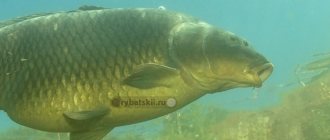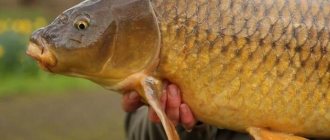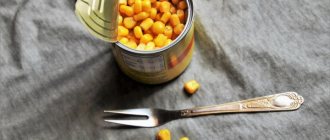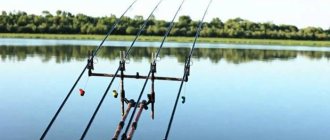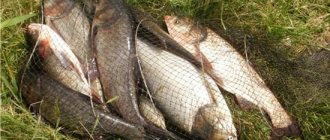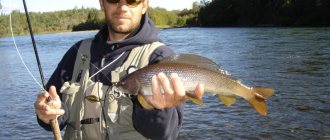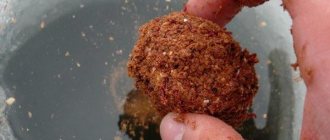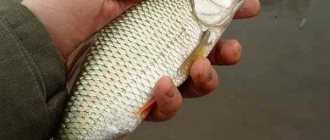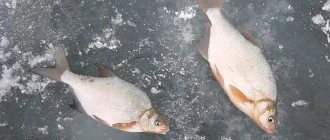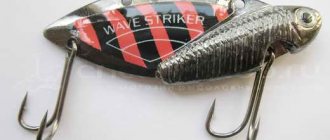Catching carp in spring
Let's look at the basic techniques for fishing for carp in the spring. They begin to catch carp around mid-April. When the water warms up to 10 degrees, you can take out carp baits, donks, feeders with equipment and try to catch carp. Tackle for catching carp in the spring consists of animal and vegetable baits: white and red worms, bloodworms, as well as canned corn and green peas.
Features of catching carp in March, April and May
To determine its habitat in a particular body of water, it is enough to pay attention to the diverging circles in the water. Sometimes fish rush to the upper layers of water to enjoy the spring sun. The best place for catching carp is snags, the area behind a sharp edge, as well as places with reverse currents and eddy currents of water, near holes, in general.
Carp lives where there is a lot of food. The structure of the bottom (silt, sand, stones) is not as important to him as the presence of a large food supply. In spring, it often approaches the coastal zone and trees. It can be caught with a fishing rod, even a fly rod with fairly coarse equipment.
In May, carp are caught using animal baits. It spawns in late spring and early, so its diet consists of energy-rich components. The worms, white and red, should be large and appetizing. They are planted several times in a bunch. The same applies to maggots: they should be large and fleshy. As the water warms up, the boilies begin to work. There are special boilies for carp. They are somewhat similar to carp, but have some differences. It's best not to confuse them.
In the article fishing in spring
you can learn how to catch other fish at this time of year.
How we catch carp
My record is not that great, but it is very dear to me. This carp, a record for me, weighed 2.5 kg. Caught on a regular bait with Japanese fishing line 0.6 mm in diameter. By the way, on a crumb of white bread, soaked in canned corn brine and kneaded to the consistency of a not too stiff dough. That day, only horses were caught using worms and corn.
In addition, if we are going to catch carp for bread, then we buy “Slavic” for this purpose. We moisten the crumb, as a rule, in Amur water and knead it in our hands until we get a piece of dough from it. Add crushed, peeled, roasted seeds to the “dough.” All this is done on the shore, does not take much time and does not even distract from fishing. In addition, Amur bream and even large horse are caught using such bread (especially in May).
We are not fans of modern fishing methods, that is, we do not buy “super gear” and do not bring bags of store-bought bait for fishing. Although our arsenal includes not only bottom tackle, but also spinning rods and telescopic fishing rods. Moreover, along with purchased wobblers, spinners and flies, we also use homemade ones. Moreover, it seems to me that newfangled gear is just another way to scam us out of money. Why do I think this?
Ammunition for fishing for carp

Naturally, the fishing rod must be powerful, even oak. If we are talking about a float rod, then its optimal length is from 7 to 10 meters. Test rods from 8 grams, since you will have to cast heavy floats.
A feeder rod for catching carp is used with dough from 150 grams. Heavy and extra-heavy rod type, length from 3.9 to 4.7 meters. It is better to use special carp rods. They are installed on the rod pod and placed on the signaling device. Nowadays there are many modifications of alarms on sale. There are remote ones that will wake up a fisherman sleeping in a tent or car; they use conventional sound and light.
The reels are placed with a baitrunner, since the carp does not take up the strength. It doesn’t take much effort for him to drag the fishing rod with him. Spool volume for reels from 5000. Hooks are used with thick wire numbers 4-6 according to the international classification.
In the spring, we definitely add chopped worms, bloodworms and maggots to the bait. If you feed him only bread, then he will not understand you well, and will simply go to another fisherman who can serve him meat, suitable dishes. The task of this fish at the end of spring is to eat heavily before spawning. The fisherman's task is to serve him so much food that he constantly spins in the fishing spot. The basic basis of bait for carp and carp has always been makha (necessarily fresh and good-smelling), grains (peas, corn, pearl barley), pellets, compound feed and boilies. The essence of fishing for carp is the same in both summer and spring: the one who feeds the most catches these fish.
Bait for carp
Bait is the basis of catching carp. With its help you can attract fish and keep them at the fishing point. Anglers who practice fishing for carp without using bait do not even suspect how much they are reducing their chances of getting a bite. After all, the likelihood that a fish will find your bait in a vast area of water is very small. Even if a carp swims two meters from the bait, it may not notice it.
It’s another matter when a fish purposefully goes to your bait by smell, finds a source of a pleasant aroma, finds food here, lingers at this point, begins to diligently eat everything edible from the bottom, and with virtually no options, your hook with bait will end up in its mouth.
You will need a lot of bait, since carp is a very voracious fish. It is unlikely that you will be able to overfeed it, but you want to keep it at the point for the entire fishing time. Not every angler can afford to use store-bought bait or pellets, but making your own bait is cheap and anyone can do it. Let's look at a few simple recipes that you can use to feed carp. In the future, you can try adding or changing ingredients, experimenting and creating your own recipes, but for starters, the ones that the ryba4ok.ru site offers you will be enough.
Recipe No. 1
The basis of the bait is peas and potatoes . You are required to cook peas separately (you can find out how to do this in this article) and potatoes. Only the article says how to prepare bait peas, but you will need bait peas, so if they are overcooked, it’s not so bad, the main thing is to add some whole, uncooked peas to the bait, which the fish can savor. After preparing both ingredients, mix them. This mixture can already be used as bait and it perfectly attracts carp with its aroma.
You can add other components - corn, a pack of commercial bait, pellets, etc. It will still work out much cheaper, since you only need a few store-bought ingredients to enhance the effect, and you can do without them.
Be sure to add an ingredient to the bait that will be used as bait. If you fish with peas or potatoes, it is clear that it is already there, and if you use, for example, a crawler, you should definitely cut a dozen crawlers into 2-3 parts and add them to the bait. This must be done directly while fishing so that the worm remains mobile.
The bait should not be completely digested or ground into mush. It must contain whole components - peas or pieces of potatoes, so that the carp remains at the fishing point for a long time, eating them. If he approaches the smell, but does not find food, he will simply go to look for food in another place.
Recipe No. 2
Millet and makha are the basis of this bait. Millet and water are taken in a ratio of 1 to 2. It is necessary to pour 2 glasses of water into the pan and put on fire. After the water has boiled, pour a glass of millet into the pan. The millet will be ready as soon as there is no water left in the pan. Most of it will be absorbed into the millet, the rest will evaporate.
Under no circumstances should the millet be allowed to burn, so stir it thoroughly during cooking, especially when there is very little water left. When the millet is ready, remove it from the stove and pour the flour into it by eye, bringing the bait to the desired consistency.
Such bait will create an excellent aroma to attract carp, but do not forget that you need to give the fish nutrients - peas, corn or the like - to keep it at the fishing point, otherwise the bait will become more attractive to small white fish. Without adding peas or corn to the bait, it is perfect for catching crucian carp, roach, silver bream and other white fish.
Catching carp in summer
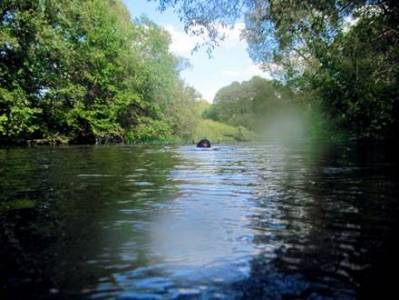
In June, carp continues to spawn, and during this period active fishing begins. As the water warms up, it goes into deeper holes to a depth of 5 to 9 meters. If you walk around with an echo sounder, you can see a flock of actively feeding carp. Its greatest activity during this period occurs between 8 and 11 o’clock in the evening, and from 6 to 12 o’clock during the day. At this time there is a lot of fresh greenery: water lilies, pondweed, reeds, and carp often approaches the shore, especially at night. If you throw a bucket of bait into the reed area, you can catch large specimens the next day.
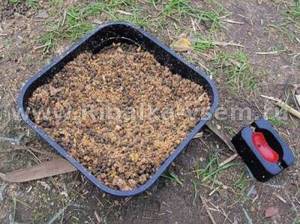
If we talk about bait, then there should be a lot of it. Large elements in the form of grains and boilies should be added in a percentage ratio of 70 to 30. The composition of 30 percent includes crackers, store-bought sprinkles, and coconut flakes. The purpose of fine-grained bait is to create a cloud of turbidity and attract fish. When they approach, they will also see large components on the table, the “second course.”
Another important point when fishing for carp is the number of days spent fishing. There should be at least two, and preferably three or more. The first day is for feeding. It is necessary to deliver a large volume of bait. For this task, rockets are used, into which food is placed. In one cast you can deliver up to 500 grams of bait.
What does carp bite on in June, July and August
Cyprinids are excellently caught using sweet corn, boilies and large dung worms. The baits should be aromatic and fresh. Fruit and chocolate syrups are used for flavoring. Nozzles are added to the bait. Only if we fish with sweet corn, then it is better to add regular, boiled corn to the bait. The bait should be a little tastier and more attractive to the fish.
Boilies are hung on special equipment. Ready-made installations are sold in the store. If desired, you can make them yourself. If the bottom is muddy, then the boilies with a hook are slightly raised above the bottom. In this position they are more noticeable to carp.
Go to the summer fishing
to get acquainted with fishing for other types of fish during this period.
Bait for carp
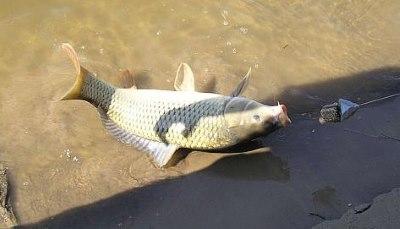
The diet of carp is quite varied. It mainly feeds on animal food that lives in algae and silt. Its natural food is:
- bloodworm;
- mayfly larvae;
- water worms;
- caddisfly larvae;
- dragonfly larvae and other living creatures.
The carp is not averse to feasting on the fry. There are frequent cases of catching carp on spinning baits and artificial fish. And when fishing with edible rubber, catching a carp is generally considered the norm. But, of course, you should purposefully catch carp only with the most effective baits, which he is unlikely to deprive of attention or which will cut off bites from small fish.
The carp's favorite delicacy, bloodworms, will not bring you success when catching it. This bait will be eaten very quickly by small fish or your main catch will be perch or crucian carp. Catching carp involves a long wait and endurance. And such bait as bloodworms simply cannot lie on the bottom without attention for the required time. The carp simply will not have time to approach it; smaller representatives of the aquatic world will be ahead of it.
Effective baits for catching carp are:
- Crawling out. Crawl is an excellent bait for catching carp. This bait cuts off bites from small fish and is very much to the taste of carp. To catch carp using a crawler, a whole worm or even a bunch of several crawlers is used. To attach the crawler, you will need a fairly large hook with a long shank. The tackle must be ready for a bite from a large carp or even a catfish.
- Dung worm . To catch carp, you can use a bunch of dung worms. It is better to fish with this bait at night, when small fish will not eat the bait. In the morning and evening hours, such bait may not work on carp due to the interfering fines.
- Potato. This bait is probably used most often by anglers for targeted catching of carp. Apart from carp, no one will bite on potatoes in the river (except for rare random bites). Therefore, having planted a potato on a hook, you can sit quietly and wait for the long-awaited trophy to be caught. To catch carp, potatoes are used, boiled with the peel. Try not to overcook it, as it will then not stick well to the hook. It's better to let it be a little undercooked. Ready potatoes can be cut into cubes of the desired size directly while fishing. Usually the cubes are cut approximately 1x1 cm. You can also use small potatoes up to 3 cm in diameter and place them whole on the hook, after first piercing the peel in several places for a better aroma or peeling it.
- Pasta. Pasta is also one of the favorite delicacies of carp and a favorite bait of fishermen. Large pasta works best. You only need to boil them lightly, literally holding them in boiling water for a couple of minutes. Then the boiled pasta is laid out on clean paper, free of foreign odors. Dry it a little in this way and you have a carp bait ready.
- Corn and peas. These baits, which work great for carp, will also be effective when catching carp. You can use canned peas or corn, or make your own. You need to put several grains on the hook - 3-5 peas or corn. You can make a “sandwich” of corn and peas on one hook. Fishing with a hair rig is much more effective. When biting, the fish swallows the bare hook, so the probability of a successful hook is close to 100%. Hair rigs can be used not only when fishing with peas or corn, but also with the same pasta or potatoes.
- Perlovitsa. The natural food of carp is pearl barley shell. This mollusk resembles a sea mussel, the only difference being that it lives in fresh water and forms colonies on the bottom. It is difficult for the carp itself to get to the meat of the pearl barley due to the strong shell of the mollusk. By taking the pearl barley out of its shell and placing it on a hook, we have a great chance of getting a bite from the carp, which will happily indulge in this unique fish delicacy. The only thing you need to take into account is that pearl barley does not hold well on the hook, so it can be used in combination with other baits that will fix it on the hook - bread crust, worm, potato, etc.
Catching carp in autumn
In autumn, carp stay on riverbed edges and wintering holes. The carp occupies pits only at the end of autumn. During this period, he stops being caught. The most productive months for catching carp are September and October. During this period, he tries to gain weight before hibernation. Fish indicate their activity by numerous splashes in the water.
How to catch carp in September, October and November

The most catchy places in the fall are steep holes located near the shore. Where there are the most trees and snags, carp probably live there. It is caught in early autumn using summer baits. In October and late autumn, animal baits work better. The aroma used is not as “aggressive” as in summer. The volume of bait for carp in the fall is slightly smaller, but not by much. The tactics remain the same: feed, feed, feed, and then catch.
Autumn fishing page
There is information about fishing for all river fish in the fall.
Check out the following topics:
On our website - Fishing
— there is a detailed
description of the carp fish
and
all the ways to catch it
with various
tackles
.
You can read how to catch certain types of fish depending on the time of year on the fishing calendar
.
Follow us on social networks
— through them we publish a lot of interesting information, photos and videos.
Popular sections of the site:
The fisherman's calendar will allow you to understand how all the fish bite depending on the time of year and month.
The fishing gear page will tell you about many popular gear and devices for fishing.
Fishing baits - we describe in detail live, plant, artificial and unusual ones.
In the bait article you will get acquainted with the main types, as well as tactics for using them.
Learn all the fishing lures to become a real fisherman and learn how to choose the right one.
The best time for winter fishing for carp

You can catch this fish throughout the winter. At the same time, the most active bite can be observed on the first and last ice, as well as at the height of cold weather, but during periods of thaw. Still, carp is more of a heat-loving fish and does not feel comfortable at fairly low temperatures. It feels great on warm winter days, when the air temperature reaches a maximum of plus. If during such periods the carp emerges from deep holes, then you need to take advantage of the moment and try to feed a hole or several holes. In order for the fish to remain in the baited area for a long time, you need to constantly add bait.
At the same time, you should not overfeed the carp, since in winter it eats little. Food should be poured into the holes in small portions. Naturally, this will require a lot of time. It’s good if the reservoir is very close, because no one will go far and feed fish tens of kilometers away, especially for someone.
Any fishing is not only relaxation, but also serious work, especially if it is winter fishing. Not only is it freezing outside, about 20 degrees, but you still need to find fish, and this requires drilling dozens of holes. It’s good if the fish is found in the first ten. It’s good if the ice is not yet completely thick and a minimum of effort and energy will be spent on drilling holes. Therefore, many winter fishing enthusiasts go fishing with the minimum task of catching at least some fish. Typically, this fish is the ubiquitous perch. To catch a fish like carp, you have to work hard and seriously.
Where to look for carp
Wild carp are bottom dwellers, so it is not advisable to look for them in shallow water. It prefers moderately warm, still water, as well as areas with little rip current. Carp, like carp, feeds exclusively from the bottom, finding food in the form of small crustaceans and insect larvae in silt and clayey sediments. It does not disdain the eggs of other fish, as well as aquatic vegetation, especially in the hot summer.
In small rivers, carp can stand and feed near steep banks, where the depth exceeds 2 meters and there is a “roof” in the form of abundant vegetation, fallen trees, branches, and stuck snags. In large rivers it sticks to deep pools and snags. In the spring, before spawning, it is also caught in small reservoirs connected to the river.
His favorite places on ponds are thickets of reeds and water lilies. Here, wild carp can also come out to feed in smaller places, in particular at night and early in the morning. In reservoirs, it has chosen the deepest areas with differences in depth, backwaters and dumps, so fishing for carp in such reservoirs is most often carried out from a boat.
Tackle for carp
Carp is a very powerful fish. Its resistance is much more powerful than that of the same carp. After hooking, the fish makes a powerful jerk away from the perceived danger - the shore or the fisherman's boat. Such a jerk can last quite a long time and can only be saved from breaking by a correctly configured clutch, which will release the line during the jerk until the carp weakens its resistance.
Even a rather modest-sized carp weighing about 2 kg can provide quite serious resistance, so you need to approach the choice of tackle responsibly if you want not only to see the carp bite and feel its powerful resistance, but also to hold the pecked trophy in your hands.
To catch carp, it is best to use a carp rod with a length of 3.3-3.6 meters and a weight of up to 100 grams. A feeder rod is also perfect, but its downside is that it may not be able to handle really large fish, so preference is still given to more powerful carp fish.
These tackles allow you to make fairly accurate and long-distance casts, and most importantly, they are equipped with a feeder, which will feed the fishing point with each cast. It is very important to cast the tackle at approximately the same point so that the carp gathers there.
The equipment needed for catching carp is something like this:
- hook;
- fishing line;
- shock leader;
- coil;
- sinker.
Hook. A round-shaped hook with a short shank is perfect for catching carp. This hook perfectly hooks a carp by the lower lip, which is a classic hook for carp fish. The hook must be of high quality and durable, able to withstand the load when fishing for large fish. The hook size is selected in the range No. 2-8. as Owner, Cobra, Gamakatsu have proven themselves very well .
Fishing line. To catch carp you will need a fishing line with a diameter of 0.3-0.35 mm. This line diameter is the golden mean, which can withstand a sufficient load and at the same time, will be as invisible as possible to the fish. Thicker line may result in fewer bites due to the wariness of the carp. The use of a shock leader will greatly increase the strength of the tackle.
Coil. A reel for catching carp will need a powerful one. It must have a low gear ratio, a spacious spool and must be equipped with a baitrunner. Choose a reel for sazzan with the following characteristics:
- spool capacity - 4500 and above;
- gear ratio 4.1:1-4.8:1;
- the number of bearings is from 2, the more bearings, the longer the reel will last, it is advisable to have a reel with 5 bearings;
- presence of a buyrunner.
When choosing a reel, it is better to rely on trusted companies. So, a Shimano or Daiwa reel with two bearings will definitely be better than any Chinese one with 5.
Sinker. To catch carp in strong currents, use a sinker weighing 100 grams or more; if the current is weak, then a sinker weighing 60-80 grams is quite suitable.
This information should be enough for a novice fisherman to understand how to catch carp and help more experienced fishermen fill in knowledge gaps or recall forgotten points. The site rybkolov.ru hopes that this information will be useful and informative for you. Have a good time fishing and no tail, no scales!
Choosing a fishing spot
When choosing a place for fishing from the shore, you need to look for an area that is convenient not for yourself, but for the fish. In order for fishing for carp to be not only exciting and successful, but also more or less comfortable, fishermen often have to set up a place for themselves in advance, clearing the shore. This approach is also considered correct because it is possible to feed the place in advance.

It is quite difficult to determine the sites of wild carp, even taking into account the fact that it does not migrate through the reservoir. Here you can use either an echo sounder or the advice of fishermen knowledgeable in this matter. But it’s not difficult to find carp feeding areas if you arrive at the reservoir before dawn and watch the water. During the morning meal, he often splashes and even sometimes appears from the water. Having found such an area, you can be sure: fishing for carp here will be successful.
Winter tackle for catching carp
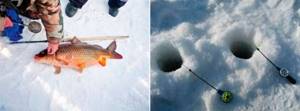
If you plan to catch carp, you should remember that this is a strong fish and weak tackle will not work for catching it. A winter fishing rod must be equipped with a fishing line with a diameter of 0.2 to 0.3 mm. At the same time, the length of the fishing line must be sufficient to allow the fishing line to be released against strong resistance. It is not advisable to use a cord for winter fishing, as it can be damaged or simply break in the cold. In this case, it is better to use monofilament fishing line, which is not afraid of such conditions.
If there are snags on the pond, then it is better to take a thicker fishing line to prevent the fish from getting the bait into snags or other obstacles. Some anglers use a fishing rod with a float, while others use a fishing rod with a nod. If a carp bites, you won’t feel much difference, but serious resistance is guaranteed and you need to be prepared for this.
The influence of temporary and weather factors on biting
Wild carp, like most other fish, behave differently at different times of the year. They begin to catch carp from the end of May. During this period, he begins to actively feed, preparing for spawning. At the end of the mating season, wild carp show little activity, but already at the end of June the fishing forecast promises an excellent bite, which will last until the end of September. With the arrival of autumn, the carp spends more and more time in its usual stopping places, occasionally going out for a walk in the morning. At the beginning of November, the biting stops altogether. It is better to catch carp at any time of the year before dawn, as well as at night.
The fishing forecast must take into account weather conditions. Carp is highly susceptible to weather dependence. The approaching bad weather significantly reduces the intensity of the bite. A decrease in pressure has a depressing effect on wild carp. There is no point in hunting it during rainy periods, but after the rainy season the carp bites quite actively. The same situation is observed during hot periods, when the fish feels a lack of oxygen. But as soon as a cool breeze blows and the temperature drops a few degrees, the wild carp “comes to life.”
Fishing for carp
The carp fights furiously and to the end. There is no need to expect him to give up like a bream gasping for air - this never happens. After hooking, this fish rushes to a place with such a snag that no fishing line can overcome it. Sometimes the carp manages to cut the line with its own serrated dorsal fin, but this happens by accident. The carp is very stubborn, so you must be careful at all stages of removing it from the water: the fish will be able to leave even when the fisherman thinks that he has already overcome it.
A landing net for carp fishing requires a wide and durable one, with a handle 1.5-2.0 m long. And in conclusion, I suggest you watch a video on how to catch carp correctly. Sincerely, the author of the blog
What to catch carp with
Carp is an omnivorous fish. It feeds on both animal and plant foods. But don’t think that by hooking whatever was at hand, you will catch a wild carp. The choice of bait must be approached very responsibly and knowledgeably.
At the end of spring and beginning of summer, carp, being exhausted by cold weather and spawning, experiences a huge need for protein, so its diet at this time is mostly animal food: water worms, insect larvae, insects themselves, crustaceans. During this period, it is recommended to catch carp with bait of animal origin. Earthworms, dung worms, bloodworms, caddis flies, and maggots are best suited for this.
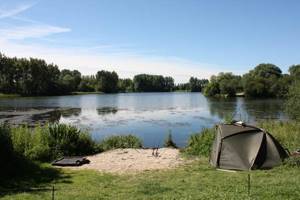
In the hot summer, the carp pays more attention to plant food, feeding on algae, aquatic plants, as well as various seeds that fall into the water. For this period, the best bait for him will be boiled or steamed cereals (wheat, peas, corn), as well as various artificial baits such as boilies or pellets.
When to catch carp
Carp is a heat-loving fish; it begins to become active from the moment winter recedes and water bodies are freed from ice. With warming, the activity of the fish only increases and gradually turns into a pre-spawning feast. Spawning of carp is observed when the water warms up to 20°C, which occurs around the beginning of June. During spawning, its biting stops and for about a week you don’t even have to think about catching it.
After the carp spawns and comes to its senses, it will begin to gradually return to active feeding, and about a week after spawning, the fish begins a post-spawning glutton, when within 1-2 weeks the fish greedily absorbs everything edible.
In summer, the activity of wild carp is inhibited by the summer heat. The lack of oxygen in the water makes itself felt and fish activity should only be counted on in the dark, when the sun is below the horizon or close to it.
In the fall, the carp regains its courage and begins to store fat for the winter. During this period, its best bite is observed, and the fisherman has the opportunity to catch his own trophy specimen, or even several. The carp greedily grabs the bait and becomes less picky about it, the main thing is that the gear can cope with the load after this strong fish bites.
Of course, in March you shouldn’t count on carp bites, since the water is still quite cold, but from the second half of April you can safely count on a positive result. At first, fishing will be more effective from morning to evening, and you should not stop fishing during the day, since in cold water the carp will continue to be active during the day, especially in sunny weather.
After its spawning, in the summer, it is already worth switching to night fishing. The best time for fishing will be from evening twilight until morning. It’s better to come fishing early, while it’s still light, so you have time to spread out, mix the bait and throw in the gear.
In autumn, while it is still warm enough, you can continue fishing at the same time as in summer. But as the weather gets colder, the night bite stops. Now the most active period for catching carp will be morning and evening. Under favorable conditions, its bite can be observed during the day. In autumn, fishing for carp is very effective. Fish fattens and you should definitely take advantage of this.
Carp, like carp, reacts very painfully to weather changes. If you know what weather is favorable for fishing, you can achieve great success.
Is it necessary to feed carp?
Baiting the fishing spot is mandatory, especially if it is a truly “wild” body of water, and you are going to catch real wild carp. Even if you do not know the location of the carp’s sites, proper systematic feeding will attract fish to the desired area.
To attract wild carp, you can use commercial bait designed specifically for this type of fish, or you can prepare it yourself. It may contain various crushed cereals, flour, breadcrumbs, confectionery flour products, dried plankton, and insect pupae.
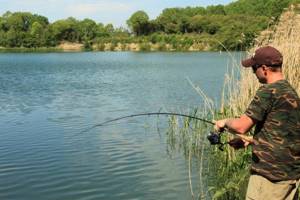
Bait for catching carp in spring and early summer must necessarily include chopped worms, food bloodworms or maggots.
For summer and early autumn, attractants (flavors) with the smell of fruits and spices are added to bait mixtures.
It is recommended to mix the bait directly at the fishing site, using water from the reservoir where you plan to fish.
Habitats of carp

From my own practice, I will say that carp is more often found near the edge of the reeds, or where there are old trees that have been fallen into the water. In shallow water it can be found due to factors such as aquatic vegetation covering only the top of the water, not allowing the water to warm up; in such places the carp rests after night gastronomic walks. The carp emerges from its hiding places only in the evening, when the scorching rays of the sun do not fall on its pond. On rivers, carp loves places with a slow flow or where the river bends. Another secret of how to find the habitats of the carp was told to us by the writer Sholokhov in the novel “Quiet Don”. The novel said that in the morning one could see where the carp was feeding by the characteristic splashes of water during the feast, the fish jumped out of the water so that I almost flew into the boat myself. There was good carp fishing in this area this morning. Arriving at a pond early in the morning, you can detect fish feeding areas by splashes of water at the edge of the reeds; if you manage to find such a place, then most of the work is already done.
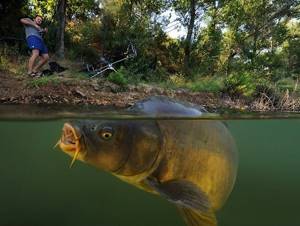
We found the place, but what does it eat and what to catch it with? The diet of carp depends on the time of year in the summer: small worms, molting crayfish, small snails, leeches. I noticed such a fact as catching carp with live bait. And this was not the case when the carp grabbed the bait by mistake, confusing it with something else. I have recorded quite a few such cases; carp were confidently caught using live bait. But this is more an exception to the rule than a pattern. In the fall, Carp will not disdain small invertebrate inhabitants of the aquatic environment or Thursday, and may completely abandon plant foods.
Well, don’t forget about boiled corn. This gourmet is good at catching corn and preferably young corn, or as experience has shown in Bonduelle, it’s hard to say why he chose this particular brand. This is, of course, not a panacea and not a 100% guarantee that you will catch 5 kg of carp with this type of corn. I just noticed that the most frequent bites were on gear loaded with this particular corn. In general, the story about the carp does not end here, we will continue to analyze this topic, wait for new articles, but for now, as they say, “Neither tail nor scales.” Bye.
Carp on the feeder
Feeder fishing today has surpassed all other types of fishing in popularity. What can I say here, the tackle is very sensitive, reliable, and most importantly - effective. In addition, the use of a feeder in equipment makes it simply irreplaceable on a flat and more or less hard bottom.
Fishing for carp using a feeder involves using the most reliable fishing rod. If you plan to catch small specimens (up to 2 kg), you can use medium action forms. For larger carp - only “parabolics”. The length of the rod is selected based on the fishing conditions, as well as the required casting distance. For fishing from the shore in the absence of coastal vegetation, forms 4-6 m long are suitable. As for the test, the choice is entirely yours, the main thing is that the weight of the feeder does not exceed it.
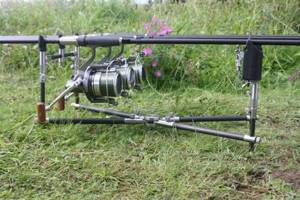
To ensure that carp fishing does not become a disappointment for you, get a good branded carp reel with a drag size of 2500-3000. It would be better if it had several replaceable spools with fishing line of different thicknesses. This will allow you to quickly adapt the gear to the size of the catch.
Now about the fishing line. Here you can’t go overboard with its diameter. For specimens up to 2 kg, a fishing line with a thickness of 0.2 mm is suitable, for larger specimens - 0.25-0.3 mm. And it’s better if it’s fluorocarbon.
The hook size is selected for the bait. For worms, bloodworms and maggots - No. 14-10, for corn, peas, boilies and other large plant baits - No. 8-4.
The type of feeder must correspond to the fishing conditions: current intensity and bottom type. For strong water flow, metal models of rectangular or triangular shapes are used, for standing water - round plastic ones.
Where do you catch carp in winter?
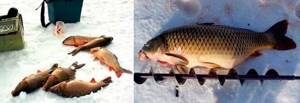
It is very possible to catch a carp if you find its location in a body of water. Like any other fish, it prefers to be at depth, where it waits out the winter. Finding it is not easy, especially on an unfamiliar body of water. As for the reservoirs of friends, where all fishing is carried out, both summer and winter, everything is simpler here, since such a reservoir has been fully studied and anglers have information about the nature of the bottom topography. As a rule, fishermen know where the holes, edges, riffles, shallow waters, etc. are located. In other words, all promising places have long been identified.
In winter, carp can be found:
- in wintering pits;
- in places where there is a boundary between flow and standing water;
- in areas where the river changes its direction.
Unlike other types of fish, carp avoids places with strong currents, as well as places with shallow depth.
It is quite natural that you will have to sacrifice precious time to find carp. If the site of this fish could not be found, then you can take a different route and try to lure the carp with the help of bait. If this fish approaches the food, it can stay here for a long time. In this case, we can say that the fishing was a success.
How to catch carp on a float rod
In some cases, a float rod is not only not inferior to a feeder, but can even surpass it. This applies specifically to fishing conditions. If the bottom of the reservoir is covered with a thick layer of silt, the feeder with equipment is simply immersed in it, hiding from the visibility of the fish. Therefore, a float fishing rod for carp wins here. It makes it possible to adjust the immersion depth of the equipment without immersing it in the silt. The angler, of course, will have to manually feed the place, but this is not such a problem.
Carp on donka
The classic donka for carp is a tackle consisting of a fishing line, a feeder with a weight attached to it, and several leashes with hooks. Improved versions of the donkey are complemented by a small but reliable fishing rod with a spinning reel. The requirements for fishing line and hooks are similar. Any feeder can be used here, but, again, based on the structure of the bottom surface.
Donka is most often used for night fishing for carp, equipped with a bite alarm in the form of a bell or a sensitive electronic device.
About the carp "nipple"
One of the varieties of carp donkey is the so-called nipple, or “makushatnik”. It differs from classic gear in that it uses not a feeder, but a piece (cube) of fragrant sunflower cake. In addition, bait is not attached to the hooks - they are inserted into this cube with their stings. But how to catch carp without using bait, you ask? Very simple!
The principle of fishing with such a device is designed specifically for carp, which, due to its natural habits, sucks on a large piece of food with its fleshy lips. At this time, the hook, along with particles of soaked cake, enters the fish’s mouth. Naturally, the carp will try to spit it out, but getting rid of a bare hook in its mouth is almost impossible. This is how self-cutting occurs.
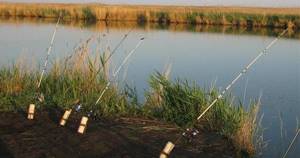
The carp bites on cake mainly from the second half of summer until the start of cold weather. Most often, this method is used for night fishing.
Lures for catching carp
It has been noticed that in spring carp are best caught using dung worms. In summer, successful worm fishing is often hampered by crucian carp. It comes to the fishing spot before the carp and eats the bait. Therefore, you have to replace the worm with another bait, for example, boiled potatoes or hard-boiled pea porridge with semolina. Homemade boilies are successfully used as bait. These boilies are prepared at home based on dough with various additives and fillings. You can also catch it simply using flavored raw dough. To ensure that the raw dough stays well on the hook, hooks with a spring are used. They are on sale, but you can easily upgrade a regular hook yourself.
Such a hook reliably holds a bait ball with a diameter of 20 mm to 35 mm - approximately the size of a cherry to a walnut. The crucian carp will no longer rush to such bait - the mouth is too small.
In addition to various cereals, dough or potatoes, I consider pearl barley meat to be an excellent spring bait for carp. Carp simply cannot resist such a treat. Pearl barley can easily be called one of the best spring baits. Corn has proven itself well. You can cook the corn yourself, or you can use canned sweet corn. The corn kernels are held securely on the hook. I plant them generously - up to ten grains. Such a bunch is clearly visible in the water and looks very appetizing. Carp accepts this bait with pleasure. And from mid-July until the end of summer, corn becomes the best bait for catching carp.
Fishing on the Amur for carp
The lower reaches of the Amur River are considered a cult place for fishing for carp. Why this particular river? The Amur has long been famous for its fish wealth, and wild carp lived there in incredible numbers. Fishing on the Amur for carp is also popular because it is here that you can catch a real trophy weighing up to 20 kg. These places even host a fishing festival to catch it. Thousands of fishermen from all over the country come here every year to fish for wild carp. Pristine nature has also been preserved here, unity with which enhances the pleasure of fishing.
Carp as it is
But what do we know about carp? Let's turn a little to science and see what science says about carp. This is a freshwater fish of the carp family. It lives in the basins of the Azov and Black Seas, the Caspian Aral Sea, as well as lakes Balkhash and Kopchegai, and the Amur River. Schooling fish Life expectancy 30-35 years. Reaches 20-25 kg of weight with a body length of more than a meter. Puberty occurs at the age of 2-3 years. Approximately 1.5 million eggs are laid at a water temperature of 18-20 degrees. The spawning process occurs from April to July. Carp mainly spawn in coastal areas in dense vegetation. Well, somehow this is what science says about our all-loved carp.
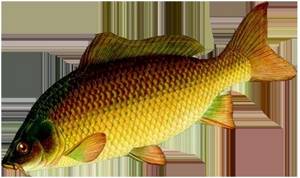
The habitats of carp are not so easy to calculate. Although he leads a sedentary life and rarely goes on the road in search of a new place of residence. However, on an unfamiliar body of water it will be difficult to find carp spots on the first try. It’s good if local fishermen give you a hint or lead you to such a place, but as a rule this happens with rare exceptions. Carp often lives in places where there is good depth, there is little noise and there is good food supply for it. These are basically backwater pits with a clay bottom. Carp does not disdain snags either. In summer, at night, carp can go out into shallow water and stand at the edge of the reeds in search of something edible. Young animals live in flocks of 5-10 individuals, while older individuals live alone. The main mistake of all novice carp anglers is that when they go fishing, they choose fishing spots based on the principle of convenience for themselves and only in the last place think about whether the fish will be comfortable here or whether the fish will live here.
Catching wild carp on the Amur River
Fishing for wild carp on the Amur differs from lake fishing, because we are faced with a current, on which we catch Amur carp. They are not similar to lake carp both in appearance and in their resistance. The river carp is a real fighter!
Fishing is focused on catching trophy carp weighing from 10 to 20 kg. The fishing spot is located at a great distance from the city. The places are wild and not fished by fishermen. Carp is a schooling fish, and if all conditions are favorable, then fishermen have moments when they don’t even have time to drink tea. We have also created all the conditions for night fishing. Moreover, large carp are often active at night.
Our team is ready to provide all conditions for catching wild Amur carp: from overnight accommodation to equipment. Experienced fishermen-experts will introduce you to feeding tactics so that you can put the fish “on point”, holding it and enjoy unique fishing for a powerful and beautiful fish in all respects. The tour program is adjusted for each group of fishermen. We work with both beginners and experienced, professional carp anglers.
Tour program
- Day 1: ◦ Meeting the group at the airport in Khabarovsk or Komsomolsk-on-Amur. ◦ Transfer by car to the fishing base located on the banks of the river. Amur. ◦ Accommodation of fishermen in fishing houses. ◦ Lunch. Bathhouse. ◦ A short briefing on the rules and features of fishing for wild Amur carp. For beginners, there is a master class on carp fishing: tackle and rigging, installation of boilies, fishing.
- Days 2-5: ◦ Rising. Breakfast. A group of fishermen, together with guides, is placed in motor boats and moves to a designated fishing spot, which is located several kilometers from the base. The “fishing point”, where the fishing process is directly organized, is equipped with all the necessary camping and other equipment. Fishing tents for carp fishing for two people, a kitchen tent, etc. are installed. The tents have special cots for each fisherman. Each fisherman has an individual carp chair and a mounting table at hand. ◦ Lunch (prepared by the chef) takes place at the fishing spot. If desired, each angler can stay for night fishing. A guide and cook also remain at the camp. The camp has sleeping bags, a generator for lighting and battery charging. The rest return to the fishing base, where dinner and a bath await them.
- Day 6: ◦ Personal preparations, transfer by car to the airport.
Duration of the tour : at least 5 days. Group: 4-6 people. Cost: 10,000 rubles/day per person
Accommodation and accommodation at the fishing base (accommodation in separate fishing houses for 2-4 people, a permanent bathhouse, a shared kitchen). There is also a fishing point (accommodation in comfortable tents, sleeping on folding beds, sleeping bag, thermal mat, shared kitchen). Meals 3 times a day (cooked by the chef). Each angler is given a life jacket, and each participant has an individual first aid kit. Guides are provided with radio communications. Transport: PVC boats with motors, cars.
Included in the price:
✔ Meeting/seeing off of the group at the airport “Khabarovsk” or “Komsomolsk-on-Amur” ✔ Accommodation at the fishing base and at the “fishing point”. ✔ Equipment for living (tents, dishes, camp furniture, carp cots, carp chairs, sleeping bags, mounting tables, tackle and equipment for fishing, bite alarms, etc.) ✔ Watercraft (boats with outboard motors) ✔ Energy supply (220V and 12V ) ✔ Satellite communications, mobile communications (agreed in advance) ✔ Meals and products for cooking throughout the tour ✔ Services of a cook and the services of guides, mechanics, fishing experts The responsibilities of guides include: general management of the tour, maintenance of watercraft, setting up a camp, loading/unloading public equipment onto boats, collecting firewood and cooking. The responsibilities of expert fishermen include: consultations on general issues during fishing, assistance in installing gear, assistance in landing fish, and other issues related to fishing for Amur carp.
Tour program with accommodation in a holiday home
If desired, accommodation can be organized on the territory of a holiday home located on the banks of the Amur River far from populated areas. This could be: a hotel with rooms or a separate house with all amenities. In their free time, fishermen can take advantage of all the available services provided by the recreation center, for example: bicycle rental, billiards, etc. This will allow fishermen to diversify their stay on the Far Eastern land and decide for themselves how they would like to spend their leisure time during a fishing tour, for example in the evening or in inclement weather.
Baits for winter fishing for carp

Carp can be caught using both traditional summer bait and not quite the usual ones. The following baits are suitable for catching this fish in winter:
- Boyles . This is a universal attachment for catching large specimens. It does not allow small fish to interfere with the fishing process. Boilies with a protein base, as well as tutti-frutti, strawberry, honey, etc. flavors will work well.
- Corn . You can use regular, boiled, or canned corn.
- Bloodworm . As a rule, a whole bunch of bloodworms is planted. At the same time, it should be remembered that bloodworms are an attractive bait for almost all types of fish. Therefore, completely different species of fish may be present in the catch.
- Worm.
- Boiled potatoes.
- Maggot.
- Mastyrka.
- Shrimp meat.
The possibility of catching a large carp on a balance beam cannot be ruled out, despite the fact that it is used to catch a predator such as pike perch or pike. Carp quite often chases small fish, which are a source of protein. Naturally, this happens very rarely, but you can always try if there is enough predator in the reservoir.
